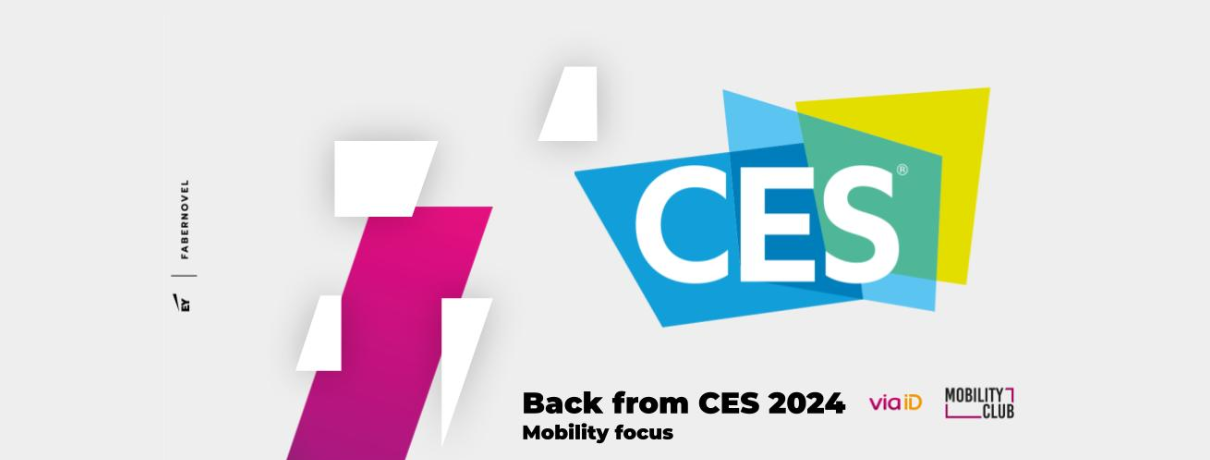
The strong CES comeback despite some notable absences
After a period marked by uncertainty, CES 2024 made a brilliant comeback, almost reaching pre-pandemic attendance figures, with 4,000 exhibitors and 150,000 participants from 150 different countries.
This edition marked the come-back of major Tech players such as Netflix, Alibaba, ByteDance. Some historical actors, specifically in the automotive sector, consolidated their presence at the show (Hyundai, Mercedes, Volkswagen, BMW, etc.), but some significant absences of key players were strongly noticed (Open AI, BYD, Tesla, Apple, etc.). As expected, the central theme of CES 2024 was Artificial Intelligence, confirming its omnipresence and its ability to redefine the boundaries of technological innovation across numerous industries.
AI Takes Center Stage with Major Announcements
AI undeniably took the spotlight at CES 2024, once again illustrating its impact across various industries and the multitude of its use cases. This edition was marked by significant announcements, especially in the automotive domain where we witnessed a true “AIvolution” with an increasingly integrated AI within cars themselves.
For instance, there was the promise of developing an AI-boosted voice assistant within certain Volkswagen vehicles. We also noted the implementation of Drive Thor, Nvidia’s embedded computing platform designed for generative AI applications, within cars from Asian manufacturers (BYD, Hyper, XPENG, Plus, Nuro, etc.).
These advancements demonstrate companies’ willingness to push the boundaries of what is technologically possible, making vehicles not only smarter and more autonomous but also significantly enhancing the user experience. AI is thus asserted as a vector of innovation, capable of radically transforming how we live, work, and move.
Major Trends at CES:
Sensorial experiences
CES 2024 highlighted the growing importance of sensorial experiences, where vision, sound, and feeling play a key role in how consumers interact with technology and brands. From LG’s transparent screens to BMW’s augmented reality driving glasses, to Razer’s haptic innovations, companies are seeking to create increasingly immersive and memorable experiences to differentiate themselves, convert new users, and strengthen brand attachment. These advancements extend beyond entertainment to practical applications, improving, for example, drivers’ safety or users’ daily well-being.
“Tech for Good”, a new trend still somewhat behind
CES 2024 also shed light on “Tech for Good” initiatives, illustrating how technology can contribute to solving some of the most pressing societal and environmental challenges. This year’s trend focused heavily on applications based on more sustainable and renewable energies such as electrification of transportation or even the promotion of cleaner energy sources (hydrogen gas turbine – Hyundai Doosan). The innovations presented reflect a growing awareness among technology sector players of their role in building a more sustainable and inclusive future, with some emerging initiatives in terms of accessibility for people with disabilities (GUIDi – A smart belt to guide the visually impaired).
Better performance and enhanced customer understanding
Data played a central role in this edition of CES; indeed, brands have a growing ambition to better understand their users, their consumption habits, the emotions felt, to simplify and personalise the experience throughout the customer lifecycle. Whether it’s through the ability to better interact with customers upstream thanks to Ontbo’s AI that analyses emotions, or the possibility to make the user experience smarter with TomTom and Microsoft’s conversational assistant, or even with Infineon and Aurora Labs’ offer to improve maintenance through AI, the goal is clear: to offer optimised, personalised, and preventive user experiences.
Collaboration is no longer an option
We remember the strong announcements of CES 2023, notably around the creation of a common standard (Home Connectivity Alliance Specification 1.0) enabling greater interoperability among home appliances actors. CES 2024 once again confirms this underlying trend and the importance of developing a collaborative ecosystem, where standards and partnerships play an essential role in accelerating innovation and maximising its impact.
Collaborations between companies, such as Amazon and BMW or Google and Samsung, illustrate the sector’s willingness to work together to develop interoperable solutions that benefit both consumers and industrial players. The mobility sector is a striking example, as many manufacturers turn to companies (such as Nvidia) that possess already developed knowledge and technologies, allowing them to deploy these new solutions reliably and quickly. In mobility, as in other industries (connected devices, smartphones, etc.), it seems increasingly clear that standardisation and alliance among actors (infrastructures, OEMs, technology companies, etc.) are no longer an option to evolve rapidly and reasonably in an increasingly complex and constantly changing context.
Some limits to note
Still, relatively few announcements focused on environmental and social issues
Despite the progress made, CES 2024 showed that initiatives focused on the environment and social issues remain insufficient. This observation highlights the urgent need for a more comprehensive and integrated approach to innovation, where ecological and social considerations occupy a central place in the development of new technologies.
AI, are we heading towards an “AIpocalypse” or an “AIvolution”?
Even if AI dominated discussions at CES 2024, its prominence raises questions about its usefulness and long-term impact. Between fears of an “AIpocalypse” and hopes for an “AIvolution” beneficial to society, the debate remains open. It is essential to continue carefully evaluating the benefits and risks (environmental impact, security, deep fakes, etc.) associated with AI to ensure that its development occurs ethically and responsibly.

